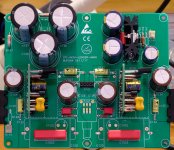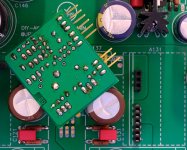But carbon/graphite... coated is to > 100 Mhz. In audio, the problem is usually the RF, aka < 1 Mhz.
It is like ferrites, cheap and generic, work only > 1 Mhz. OK with video band but unuseful with audio band.
Würth has an expensive ferrites that attenuates > 150 kHz. I have a lot, which attenuate half of the Schaffner RF/EMI FN9244B filters.
If two filters is too much, I try with one filter and the Würth 150 kHz ferrite. With my Marantz, in the chain: two filters and one ferrite.
It is like ferrites, cheap and generic, work only > 1 Mhz. OK with video band but unuseful with audio band.
Würth has an expensive ferrites that attenuates > 150 kHz. I have a lot, which attenuate half of the Schaffner RF/EMI FN9244B filters.
If two filters is too much, I try with one filter and the Würth 150 kHz ferrite. With my Marantz, in the chain: two filters and one ferrite.
Last edited:
In Tarragona we have two active nuclear reactors at 80 Km. A BIG petro-chemical pole, I think is the second biggest in the Mediterranean, at 5 Km. And a great theme park at 10 Km. I believe that the problem in the electrical grid is for these last two.
[Catalan] Complex Petroquimic de Tarragona - Viquipedia, l'enciclopedia lliure
[Big IMG] https://upload.wikimedia.org/wikipe...1280px-Petroquímica_de_Tarragona_nocturna.jpg
[Big IMG] http://2.bp.blogspot.com/-b5xU1yM5YQU/U0e3Gi03jRI/AAAAAAAAA0c/n0_A3GrDec8/s1600/01.jpg
[Catalan] Complex Petroquimic de Tarragona - Viquipedia, l'enciclopedia lliure
[Big IMG] https://upload.wikimedia.org/wikipe...1280px-Petroquímica_de_Tarragona_nocturna.jpg
[Big IMG] http://2.bp.blogspot.com/-b5xU1yM5YQU/U0e3Gi03jRI/AAAAAAAAA0c/n0_A3GrDec8/s1600/01.jpg
Last edited:
Off topic
I would need to write a lot to explain all the tweaks.
The problem with OS is that they are commonly used, they do not work only with multimedia. The soft players also have to be configured well, as well as the outputs (ASIO/ASIO4ALL, Kernel Streaming, Wasapi... ).
The BIG problem in ALL computers is like the CPU works with the internal registers and the data in the HDD/SD. It is not just a matter of priorities in processes, execution, I /O, memory ... is too how the CLOCK is managed!
The CPU generates a lot of noise, jitter or whatever, making the sound has "digititis", digital glare, losing naturalness, credibility, 3D, analogue sound... which are the symptoms that are associated with jitter.
It is a problematic issue. I decided to verify for myself if what others said was true, and that is the way it is. I think nobody has measured it yet, or I have not heard.
Now I get excited more times and more intensely, which for me is proof enough.
I would be interested to know more about that. I have Win10 version 1803 64-bit.
I would need to write a lot to explain all the tweaks.
The problem with OS is that they are commonly used, they do not work only with multimedia. The soft players also have to be configured well, as well as the outputs (ASIO/ASIO4ALL, Kernel Streaming, Wasapi... ).
The BIG problem in ALL computers is like the CPU works with the internal registers and the data in the HDD/SD. It is not just a matter of priorities in processes, execution, I /O, memory ... is too how the CLOCK is managed!
The CPU generates a lot of noise, jitter or whatever, making the sound has "digititis", digital glare, losing naturalness, credibility, 3D, analogue sound... which are the symptoms that are associated with jitter.
It is a problematic issue. I decided to verify for myself if what others said was true, and that is the way it is. I think nobody has measured it yet, or I have not heard.
Now I get excited more times and more intensely, which for me is proof enough.
Last edited:
Hi Maty
Thank you for your questions - I have just returned from Perth, 2750 kms and my arms are tired!
24 steps 50k SA and the entire case is 3mm CN Am folded.
Good health in 2019 for you and your family.
Hugh
Thank you for your questions - I have just returned from Perth, 2750 kms and my arms are tired!
24 steps 50k SA and the entire case is 3mm CN Am folded.
Good health in 2019 for you and your family.
Hugh
And I thought you were in NY.
Compare Attenuator Types
Detailed Information
I am used to the 0.5 dB and 1 dB (my Marantz) of digital attenuators.
Compare Attenuator Types
Detailed Information
Here is the dB steps chart, which applies to all standard Goldpoint 24-position stepped attenuator values:

2 dB by step.Our off-the-shelf stepped attenuators supply the correct amount of attenuation for most audio systems. But with some systems which have relatively low overall gain, you might have to turn the knob up past the 12 o'clock position to achieve normal listening levels. And some systems with relatively high gain cause the volume level to be too loud after turning the knob up to only the 4th or 5th position. These conditions are easy to remedy, however, as explained below. The graph shows standard and modified stepped attenuator tapers. The blue line is the standard Goldpoint taper.
I am used to the 0.5 dB and 1 dB (my Marantz) of digital attenuators.
Last edited:
Khozmo, High Quality Audio & Industrial Attenuators and Passive Preamplifiers
Number of steps: 48
Attenuation range: -60 dB ... 0 dB
Attenuation per step: steps 1 to 11 - 2dB, 12 to 48 - 1dB
But $$$, like the expensive DACT.
Number of steps: 48
Attenuation range: -60 dB ... 0 dB
Attenuation per step: steps 1 to 11 - 2dB, 12 to 48 - 1dB
But $$$, like the expensive DACT.
Last edited:
Is that cheap chinese 21 step DACT ok for the Lender preamp?
Is it better than the 10KOhms potentiometer from the Mouser? Like the (688-RK09L12D0A1W)
Is it better than the 10KOhms potentiometer from the Mouser? Like the (688-RK09L12D0A1W)
Some experienced and respected members on the forum have reported very good feedback on these cheap DACT type attenuators and I now regret not getting one of these.Is that cheap chinese 21 step DACT ok for the Lender preamp?
I don't want to spark a debate on attenuators, but I had bad luck with one of these in my Lender. It made the most horrible scratching sounds when changing gears. Must be something wrong with the mechanics inside.
Is it the attenuator or is there DC running through it, making the scratching noises??
Measure it and see or try a normal trimmer (POT) to compare.
If I think of anything else I'll let you know.
Measure it and see or try a normal trimmer (POT) to compare.
If I think of anything else I'll let you know.
@Harry3 – thank you for your help. That attenuator was very quickly replaced with a Bourns (91 Pro Audio series) pot and is now in my spare parts bin – probably never to be used again since the Aksa Lender preamp is sooo good, it is the last preamp I will ever need or build.
Hi. Have been busy with other stuff, but some extra components arrived.
Still waiting for some extra resistors, the DACT SMD volume switch, and the box, etc.
Can anyone see if the main board is ok so far? It just needs R141 and the volume switch.
Still waiting on some resistors for the THT boards, and heat sinks.
Have the HP 90W 19V 4.74A AC Power supply from the laptop supply.
Have the DC-DC Boost Converter Step-up 250W 10A 8.5-48V to 10V-50V Power... (hope that is the correct one!)
Still waiting for some extra resistors, the DACT SMD volume switch, and the box, etc.
Can anyone see if the main board is ok so far? It just needs R141 and the volume switch.
Still waiting on some resistors for the THT boards, and heat sinks.
Have the HP 90W 19V 4.74A AC Power supply from the laptop supply.
Have the DC-DC Boost Converter Step-up 250W 10A 8.5-48V to 10V-50V Power... (hope that is the correct one!)
Attachments
Maf_Au,
Beautiful work - very neat! Looks good to me. Make sure you use edge card socket connectors for the DB rather than solder in directly.
Your PSU looks good but 19v laptop supply is overkill probably. A cheap class 2 wall wart transformer from an old WiFi router at 12v and 1000mA will suffice and probably less noisy than laptop supply. Although HP laptop bricks are some of the best and quietest ones around, so should work well.
Beautiful work - very neat! Looks good to me. Make sure you use edge card socket connectors for the DB rather than solder in directly.
Your PSU looks good but 19v laptop supply is overkill probably. A cheap class 2 wall wart transformer from an old WiFi router at 12v and 1000mA will suffice and probably less noisy than laptop supply. Although HP laptop bricks are some of the best and quietest ones around, so should work well.
Why ?......Make sure you use edge card socket connectors for the DB rather than solder in directly.
Dan.
So that you can remove it to service it or swap it out. Unless you have no intention of ever swapping it out (for different gain or components for use as HPA), then solder directly. However, servicing a vertical DB is not easy.
Maf_au – I agree with X – beautiful work!
I would also advise to use socket connectors on the motherboard for R121 (the pot) for easier connecting to your panel mounted DACT volume switch. I soldered wires from my panel mounted attenuator directly onto the board and regretted that later when I replaced the cheap problematic stepped attenuator with a Bourns pot. Difficult to solder between the caps there.
I would also advise to use socket connectors on the motherboard for R121 (the pot) for easier connecting to your panel mounted DACT volume switch. I soldered wires from my panel mounted attenuator directly onto the board and regretted that later when I replaced the cheap problematic stepped attenuator with a Bourns pot. Difficult to solder between the caps there.
- Home
- Source & Line
- Analog Line Level
- AKSA's Lender Preamp with 40Vpp Output

